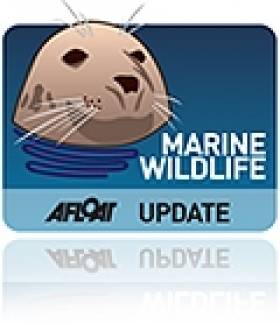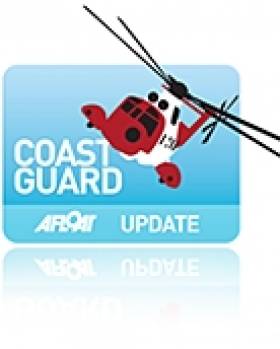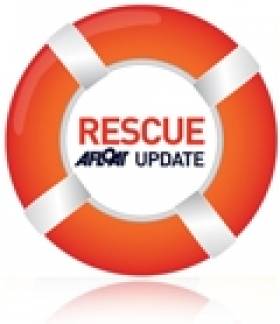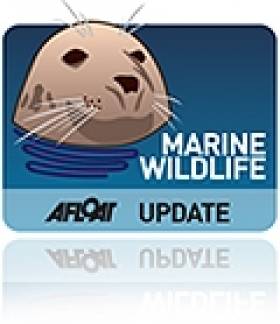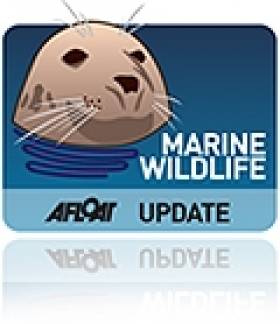Displaying items by tag: Donegal
Video Shows Kayaker's Close Encounter With Basking Shark
#MarineWildlife - An angling kayaker has spoken of his surprise at being "stalked" by a basking shark off Donegal.
The Irish Times yesterday posted video of the close encounter captured by Graham Smith while paddling along the coast.
As Smith told the Irish Independent, he was only hoping to catch a tope shark when he came upon a school of basking sharks off the Inishowen Peninsula.
And when one of them started following him, Smith went into panic mode - but soon realised the shark was more interested in the slipstream of his kayak, which provided a steady source of plankton for the giant filter feeder.
The second biggest fish in the sea after the whale shark, basking sharks are now a regular sight in Irish waters, with protections on the endangered species resulting in a boom in numbers.
Coastguard Crew Delivers Baby Boy in Donegal
#Coastguard - The Irish Coast Guard dealt with a lifesaving of a different kind on Friday night (19 July) when one of the crew of the Sligo-based rescue helicopter helped deliver a baby boy.
As TheJournal.ie reports, the delivery happened after the coastguard crew had airlifted a woman in advanced labour from Arranmore off the Donegal coast to Letterkenny.
When she began to give birth in the hospital corridor, Rescue 118 crewman Gary Robertson stepped in to help bring the healthy baby boy into the world.
TheJournal.ie has more on the story HERE.
Four More Drownings Bring Renewed Water Safety Appeal
#WaterSafety - Four more people have drowned in separate incidents around Ireland as the heatwave continues.
As RTÉ News reports, a 24-year-old man died while swimming in the sea near Ardara in Co Donegal yesterday afternoon (20 July).
Later, the body of a second victim was recovered from the Shrule River in Newtownstewart, Co Tyrone after getting into difficulty.
A third man in his 60s is was drowned after failing to return from a swim in a quarry near Carrick-on-Suir. His body was recovered earlier today.
The tragedies follow news of a 19-year-old who drowned while swimming with friends in Lough Leane in Killarney on Friday evening (19 July).
And a woman in her 30s was lucky to be rescued after getting into difficulty swimming in the River Nore near Kilkenny. She is currently in a serious but stable condition in hospital.
Irish Water Safety have renewed their appeal for the public to take extra care when taking to the water during this extraordinary hot weather that had already claimed seven lives as of Thursday last.
Elderly Woman Survives Fall From Europe's Highest Sea Cliff
#Rescue - An elderly woman was rescued on Thursday 11 July after slipping off the highest sea cliff in Europe.
The Belfast Telegraph reports that 71-year-old Vera Flynn became separated from her sister while walking the cliff path at Slieve League in Co Donegal.
According to the Donegal Democrat, it's believed she took a wrong turn on the path and slipped down the cliff face, becoming trapped in a ravine 400 metres from the top.
After a search lasting many hours, the woman was located by the Killybegs Coast Guard cliff rescue team and winched to safety, reportedly uninjured in her ordeal.
“There’s no doubt that this lady’s exceptional fitness helped her in this situation, given that she was out such a long time and it was such a hot day," said Killybegs coastguard press officer Shane McCrudden.
Strange Case of Stranded Dolphin Found Two Miles Inland
#MarineWildlife - In a week that saw the Isle of Man's first sighting of a humpback whale for three years, BBC News reports on the strange discovery of a rare species of dolphin two miles inland from the shore in Co Donegal.
The carcass of an Atlantic white-sided dolphin was found on a hillside near Meenbanad with head injuries - but no one knows how it got there.
Pádraig Whooley of the Irish Whale and Dolphin Group (IWDG) said it's most likely that someone found the dead cetacean on the beach and took it to the hillside to decay so that its skeleton could later be retrieved.
The dolphin is thought to be one of a pod that beached at Traigheanna Bay in Dungloe on 21 June. The species is a rare sight in Irish coastal waters, said Whooley, because they tend to feed much further out at sea.
In other stranding news, the IWDG reports that a bottlenose dolphin who live stranded at Beal in Co Kerry last summer has been recorded in the Shannon Estuary with her calf on a number of occasions this month and last.
The Shannon Dolphin and Wildlife Foundation has more on the sightings of the dolphin they now call Sandy Salmon.
Killer Whales Surprise Angling Brothers Off Donegal
#MarineWildlife - Following the good news of the beached whale rescue in Co Meath today, the Irish Independent reports on a surprise killer whale sighting in Donegal.
Sea angling brothers John and Pat Cunningham described the "beautiful sight" of two orcas who emerged from the water by their rowing boat half a mile from the coast off Glencolmcille.
"I've only ever seen them in the North Sea when I was commercial fishing up there", said John of the unexpected rendezvous.
The Irish Whale and Dolphin Group's record of the sighting speculates that the killer whales may be the same pair spotted off Mizen Head in Cork on 11 June and Slea Head in Kerry a day later.
Killer whales are a rare sight so close to the shore but they are no strangers to Donegal - as last year's appearance of a well known orca pod in Lough Swilly demonstrates.
However, fears were expressed earlier this year that that particular family, often seen off the coasts of Scotland and Ireland, is on the 'brink of extinction'.
#Tourism - The world-class surfing hotspot of Sligo has failed to make the grade in Fáilte Ireland's long list of leading tourism towns for 2013, according to the Irish Independent.
The north-east county was among a surprise selection of areas known for their maritime and waterways attractions - such as Westmeath on the Shannon and Galway, host of last year's Volvo Ocean Race finale - that were not featured in the Irish tourism board's list of 45 towns and villages put forward for the Highly Commended Tourism Towns award, part of the National Tidy Towns Awards to be announced later in the year.
Counties on the water that did make the cut include Clare and Mayo, with five towns each on the list, Kerry with four - including last year's winner Portmagee - and Donegal and Waterford, represented three times each.
The top prize winner, to be announced by Fáilte Ireland in November, will receive €10,000 in supports for tourism marketing and development.
Though Sligo is conspicuous by its absence, Donegal's triple placing shows the north-east region is a big tourism attraction - and the Tripclocker blog says surfing is at the forefront of that.
With Ireland's exposure to the open Atlantic giving is "better waves more often", according to Killian O'Kelly of Bundoran's Turn n' Surf, there is a wide variety of surf beaches stretching from Donegal to Clare in particular with swells for all levels of experience.
#Surfing - Two national broadcasters will base themselves in Bundoran this week ahead of the Sea Sessions Surf Music Festival at the weekend.
Today FM’s KC Show will broadcast live from the Bundoran RNLI Lifeboat Station tomorrow 19 June and Thursday 20 June, while 2FM will broadcast from the Sea Sessions from Friday 21 to Sunday 23 June, giving the seaside town unprecedented national media coverage for five days.
As part of a recent Discover Ireland promotion on Today FM, listeners were asked where to send the various shows to on their holidays. Listeners to the KC Show had a choice of sending him to Dingle or Donegal and following thousands of votes, Donegal came out on top.
One of the locations suggested was Bundoran, and the RNLI Lifeboat station at the pier was chosen as the home for the KC Show for two daily broadcasts this week complete with live musical guests Walking With Cars and new Irish act Daithi.
No sooner will Today FM have packed up than the 2FM Roadcaster will be rolling into the Main Beach car park and preparing to broadcast from the Sea Sessions on Friday, Saturday and Sunday.
The national state broadcaster will give the festival unprecedented coverage with over 20 hours scheduled live from the beachfront. Jenny Greene, Cormac Battle, Ruth Scott and Paddy McKenna will all host their shows live across the weekend.
Bundoran tourism officer Shane Smyth commented: "I am thrilled that not one but two national broadcasters will be in town this week. It will be a welcome boost to the ongoing promotion of Bundoran as a destination.
"Speaking as Bundoran RNLI volunteer lifeboat press officer also, I’m obviously delighted that the RNLI will benefit from two days of national coverage and I know that KC and his team are keen to find out more about the lifeboat service here in Bundoran."
Smyth added: "The guys from 2FM had a great time when they were here a few weeks ago and we look forward to welcoming them again over Sea Sessions weekend. Last time they were here they brought scorching sunshine with them – let’s hope they do the same again!”
Sea Sessions is Ireland's "biggest and best" surfing and music festival and returns for its sixth successive year in 2013. Based in Bundoran, the festival also includes surf tour events in Lahinch, Co Clare and nearby Sligo.
Beaked Whale Strandings Total 3 For May
#MarineWildlife - Another beaked whale stranding has been recorded on the Irish coast just weeks after two of such creatures were found in Donegal.
A ranger with the National Parks and Wildlife Service (NPWS) made the discovery at Aillebrack in Co Galway on the evening of 27 May.
The 5m carcass of a female - like the female and juvenile found in the northwest - is thought to be either a True's or Sowerby's beaked whale.
Mick O'Connell, strandings officer with the Irish Whale and Dolphin Group (IWDG), says the latest stranding "raises new questions", with suspicion that its death may be linked to the face of the Donegal pair earlier this month.
As previously reported on Afloat.ie, beaked whales are a rare occurrence in Irish waters, with the last record before this month' stranding made in 2009.
Dolphins 'Say Thank You' After Fish Farmer Rescue
#MarineWildlife - Two dolphins saved from stranding on a beach in Donegal leapt from the water "as if to say thank you" after their rescue by a local fish farmer.
The Belfast Telegraph reports that salmon farmer Shea Coyle and his father Michael acted quickly after noticing what at first looked like two upturned surfboards on Downings beach near Fanad.
But what looked from afar like surfboard fins turned out to be the fins of two dolphins that had become trapped in the sand.
Shea described how the dolphins were "trying desperately to wriggle free" before he leant a hand to heave them back into the water.
"After about 10 minutes I got one dolphin safely out into deeper water and he stayed there whilst I got to work on the other."
Once the second dolphin was free, the pair "just took off" - and were later seen by the Coyles from a nearby peer, giving what might just have been a show of thanks.
The happy story in Donegal occurred not long after a series of dolphin and whale strandings in the northwest described as "unusual" by the Irish Whale and Dolphin Group (IWDG).



























